The castle site is on a high point overlooking a river. Like most British castles, it now bears a marked resemblance to a pile of rubble, but there is enough left to interest the visitor. Said to be the largest castle in Devon. If the signposting in the town proves a bit vague, head upwards and look out for Castle Lane.
Category: English Heritage
Tintagel Castle, Cornwall
English Heritage
The site is encrusted in Arthurian myth. In reality, dramatically sited low walls are all that remain of a 13th century castle. Some parts of the site have succumbed to sea erosion. The remains extend on both sides of a gorge that separates the headland from the mainland. Castle aside, it’s interesting to wander around the headland, which is littered with ancient remains. There are sea views.

Pendennis Castle, Cornwall
English Heritage.
The castle was built as one of Henry VIII’s coastal gun forts, and the site continued in use as a military strongpoint up to the Second World War. Besides the original castle, the site includes substantial stone-built barracks buildings from more recent times. Suggested visit time: about 2 hours. There is plenty to look at, with sea views, and you could also take a boat trip across the estuary to visit St Mawes castle nearby.
St Mawes Castle, Cornwall
English Heritage.
One of the best-preserved of Henry VIII’s coastal artillery fortresses. It is built in an interesting clover-leaf shape, and has been little altered. Be careful of headroom when exploring the upper parts – I banged my head so hard it felt like my neck had become shorter 🙂 It can be visited in conjunction with the larger Pendennis castle nearby, if you make a harbour ferry trip between the two.
